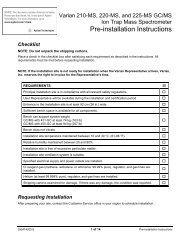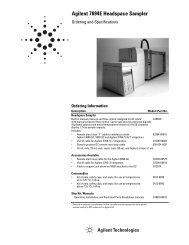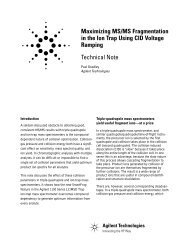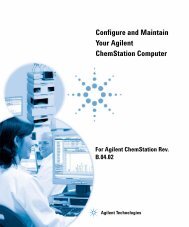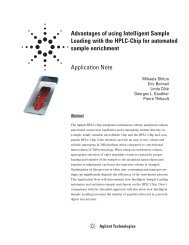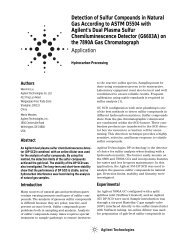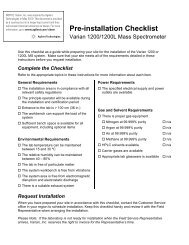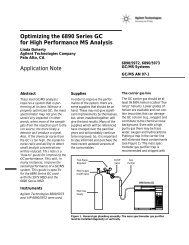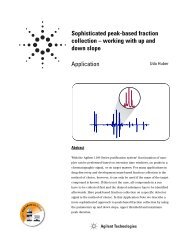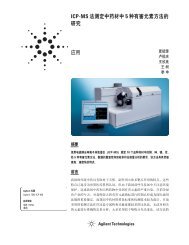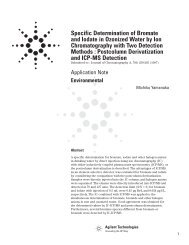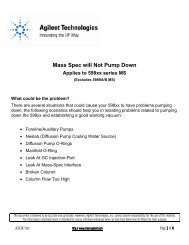and Multimode Inlet for Drinking Water Analysis - Agilent Technologies
and Multimode Inlet for Drinking Water Analysis - Agilent Technologies
and Multimode Inlet for Drinking Water Analysis - Agilent Technologies
Create successful ePaper yourself
Turn your PDF publications into a flip-book with our unique Google optimized e-Paper software.
New 7693 Autosampler<br />
<strong>and</strong> <strong>Multimode</strong> <strong>Inlet</strong> <strong>for</strong><br />
<strong>Drinking</strong> <strong>Water</strong> <strong>Analysis</strong><br />
Easier Methods Development<br />
<strong>and</strong> Improved GC <strong>and</strong> GC/MS<br />
Sensitivity<br />
Mike Szelewski<br />
<strong>Agilent</strong> <strong>Technologies</strong><br />
Wilmington,DE<br />
April 22, 2009
If you could…<br />
Run more samples in your sequence<br />
Improve detection limits<br />
Automate tedious sample <strong>and</strong> st<strong>and</strong>ard preparation steps<br />
H<strong>and</strong>le active compounds better than be<strong>for</strong>e<br />
Make large volume injections without spending a long time on<br />
method development<br />
Get better precision<br />
…wouldn’t you be happy!
Two New Products from <strong>Agilent</strong> to Enhance Lab<br />
Productivity<br />
<strong>Agilent</strong> 7693A Automatic Sampler<br />
<strong>Agilent</strong> <strong>Multimode</strong><br />
<strong>Inlet</strong>
New 7693A Automatic Liquid Sampling System<br />
New Injector with 16<br />
Vial Positions<br />
New Tray with 150<br />
Vial Positions<br />
Page 4
7693A Injector & Tray Features<br />
• 16 (Injector) <strong>and</strong> 150 (Tray) , 2mL samples<br />
• Removable, 50 vial sample trays<br />
Setting (injecting<br />
into S/SL inlet)<br />
Precision<br />
(%RSD)<br />
• Injections from 1-50% of syringe size in<br />
20% to 50% 0.30%<br />
1% increments<br />
10% 0.80%<br />
• Modular, field repairable<br />
2% 1-2%<br />
• Self Calibrating, alignment like 7683B<br />
1% 3-5%<br />
• LVI (Large Volume Injection to 250µl per injection)<br />
• Single Sample Heater, Barcode reader/ mixer<br />
• Active gripper<br />
• Compatible with all 6890, 7890, 7820 <strong>and</strong> 6850<br />
(Injector Only)<br />
• Optional heater/chiller plate (requires circulating bath)
Removable 50 Vial Sample Tray <strong>for</strong> 2 ml Samples
New 16 Sample Capacity in ALS Injector<br />
7673C<br />
7683B<br />
7693A<br />
Page 7
S<strong>and</strong>wich Injections with 7693A<br />
• S<strong>and</strong>wich Injections are possible with single tower<br />
• Air gaps are optional
Lifetime <strong>and</strong> Reliability Testing<br />
• Lifetime be<strong>for</strong>e failure – 120,000000 injections
Sample Prep Programming Flexibility<br />
S<strong>and</strong>wich injections ( up to 3 layers with air gap)<br />
• Examples of Simple liquid manipulation<br />
• ISTD addition<br />
• Reconstitution<br />
• Mixing (Requires Bar Code Reader / Heater/ Mixer option)<br />
• Dilution<br />
• Derivatization<br />
• In Vial Extraction<br />
Ambient<br />
In-vial Small-Volume Derivitization Dilution Internal St<strong>and</strong>ard Heating/Mixing<br />
Headspace Extraction ti Sampling Addition Bar Code
Example Sample Prep Method <strong>for</strong> Preparing<br />
St<strong>and</strong>ards<br />
Prepare 7 levels of st<strong>and</strong>ards, plus a blank<br />
Add varying amount of solvent to vials with inserts (270 – 300 uL )<br />
• Use a wash bottle as a solvent source in rear tower<br />
Add varying amount of st<strong>and</strong>ards to 7 vials ( 30 – 0.3 uL)<br />
• Stock st<strong>and</strong>ards solution in a front turret position<br />
Add fixed amount of ISTD solution to 8 vials ( 3 uL)<br />
• Stock ISTD solution in a front turret position<br />
Total 100 steps – 50 minutes plus 10 minutes setup
Compare Manual prep vs 7693A prep, Ratio of<br />
%RSDs of RRFs from 7 level cal<br />
2<br />
1.8<br />
16 1.6<br />
1.4<br />
1.2<br />
1<br />
0.8 08<br />
0.6<br />
0.4<br />
0.2<br />
%RSD Automated / %RSD Manua<br />
0<br />
IS Acenaphthene-d10<br />
SS 1,3-dimethyl-2--<br />
nitrobenzene<br />
Hexachlorocyclopentadienee<br />
IS<br />
Di(2<br />
Mevinphos<br />
2,4-Dinitrotoluenee<br />
Fluorenee<br />
Atrazine<br />
Chlorothalonill<br />
Bromacil<br />
Aldrin<br />
Heptachlor epoxidee<br />
SS Pyrene-d10<br />
Endrinn<br />
p,p'-DDT<br />
IS Chrysene-d12<br />
-Ethylhexyl)adipatee<br />
SS Triphenylphosphate<br />
e<br />
thylhexyl)phthalatee<br />
Endrin Breakdown<br />
DDT Breakdown<br />
bis(2-E<br />
Isophorone<br />
Trifluralin<br />
Phenanthrene-d10<br />
Simazine<br />
Pentachlorophenol<br />
Terbufos<br />
IS Perylene-d12<br />
7693A is as good as a skilled chemist when making a<br />
7-level calibration set
New <strong>Multimode</strong> <strong>Inlet</strong> <strong>for</strong> Gas Chromatography
Current <strong>Agilent</strong> PTV – Support Issues<br />
Plugged split line<br />
Needle binding<br />
Leaks at liner<br />
Broken liner<br />
Only cryogenic<br />
cooling<br />
Small liner<br />
volume<br />
Stripped threads<br />
Page 18
<strong>Agilent</strong>’s New Programmable <strong>Inlet</strong> - MMI<br />
7890 turn-top<br />
7890 st<strong>and</strong>ard<br />
pneumatics<br />
Air plus CO2, N2<br />
cryogenic cooling<br />
Uses 7890 S/SL<br />
liners, septa <strong>and</strong><br />
o-rings<br />
Thermocouple<br />
sensing<br />
7890 st<strong>and</strong>ard<br />
d<br />
capillary fitting
Hardware<br />
<strong>Agilent</strong> <strong>Multimode</strong> <strong>Inlet</strong> Features<br />
Temperature range of -160ºC to 450ºC<br />
Heating @ 15ºC/sec<br />
Septum/Liner Easily Changeable<br />
Injection Modes: Hot S/SL, Cold S/SL, PTV in pulsed mode, solvent vent mode,<br />
residue removal mode<br />
Support <strong>for</strong> single stroke injections from 0.1 μL to 250 μL<br />
EPC Compatible with Packed Liners<br />
Compatible with 7890A, 5975C, 7683A/B, CTC Combi PAL<br />
Software<br />
Ten temperature ramps<br />
Solution <strong>for</strong> solvent vent timing<br />
Integrated into ChemStation, MSD ChemStation, EZChrom, MassHunter
MMI Programmable Temperature<br />
Vaporizing <strong>Inlet</strong><br />
– injection modes<br />
Hot split/splitless (also pulsed)<br />
• similar to the S/SL inlet using the same liners<br />
Cold split/splitless (also pulsed)<br />
• Significantly more inert than hot splitless<br />
• Can inject 3-5 uL with no solvent venting<br />
• Better sensitivity than hot splitless because large vapor cloud<br />
is not <strong>for</strong>med which travels outside the liner <strong>and</strong> portions are<br />
lost<br />
LVI-Solvent Vent<br />
• An extension of cold splitless<br />
• Large volume injection <strong>for</strong> maximum sensitivity
Multiple Mode GC <strong>Inlet</strong> - Cold Injections<br />
• No syringe-needle discrimination; Minimal inlet discrimination<br />
• No special syringes, liners or consumables<br />
• Large volume injection (5ul to 250ul) - lower detection limits<br />
• Solvent vent/matrix vent - decrease interference / maintenance<br />
• Flexibility (hot/cold split/splitless, temperature programmed vaporization)<br />
• Cold trapping in liner - improves chromatographic peak shape, resolution<br />
• Capillary column backflush with CFT - decreases cycle time, maintenance
MMI Cold Splitless <strong>and</strong> SV – Temperature<br />
<strong>and</strong> Flow Programs<br />
Cold Injection<br />
Transfer of sample<br />
from inlet to column<br />
GC Separation<br />
0.9 min<br />
MMI Temp<br />
20 350<br />
GC Oven<br />
Oven = 40<br />
Temp<br />
MMI<br />
cooldown<br />
Oven ramps<br />
Purge<br />
Status<br />
purge off<br />
purge on<br />
Min 0 0.05 0.6<br />
1.5 2.5 26
<strong>Multimode</strong> Injection of Triazine Herbicides<br />
1µL Cold Splitless injection<br />
1µL Hot Splitless injection<br />
5.52 5.54 5.56 5.58 5.60 5.62 5.64 5.66 5.68 5.70 5.72 5.74 5.76 5.78 5.80<br />
1, 2, 3 <strong>and</strong> 4 µL Cold splitless injections (ethyl acetate)<br />
5.55 5.60 5.65 5.70 5.75 5.80 5.85 5.90 5.95 6.00 6.05 6.10 6.15 6.20 6.25
Compare cold to hot splitless S/N using the new<br />
<strong>Multimode</strong> <strong>Inlet</strong> on a 7890-5975 GC/MSD system<br />
Most “active”<br />
compound<br />
gives largest<br />
improvement<br />
Ratio<br />
RT Mass Cold S/N :<br />
Hot S/N<br />
Fluorene 11.152 166 1.36<br />
Aldrin 15.205 66 1.33<br />
263 1.33<br />
improvement Mevinphos 9.338 127 1.33<br />
Pentachlorophenol 12.989 266 2.19<br />
Endrin 17.600 263 1.48<br />
p,p'-DDT 18.600 235 1.51
Area Ratios of 1-5 uL Cold SL to 1 uL Hot SL using<br />
the New MMI, single taper helix liner<br />
Normalized hot splitless area = 1
Compare hot-to-cold splitless %RSDs using the new MMI<br />
on a 7890-5975 GC/MSD system, 7 level cal
PTV - Solvent Vent (elimination) Mode<br />
Syringe<br />
needle<br />
Baffled<br />
Liner<br />
• Set inlet temperature at or<br />
below solvent boiling point<br />
Carrier<br />
• Set high split ratio<br />
Vent<br />
• Inject sample very slowly<br />
into PTV<br />
• Solvent evaporates through<br />
split vent<br />
Sample<br />
Analyte<br />
Solvent<br />
Column<br />
• Close split vent <strong>and</strong> ramp<br />
PTV temperature<br />
• Carry out separation on<br />
analytical column
MMI Cold Splitless <strong>and</strong> SV – Temperature<br />
<strong>and</strong> Flow Programs<br />
Cold Injection<br />
Transfer of sample<br />
from inlet to column<br />
GC Separation<br />
0.9 min<br />
MMI Temp<br />
20 350<br />
GC Oven<br />
Oven = 40<br />
Temp<br />
MMI<br />
cooldown<br />
Oven ramps<br />
Purge<br />
Status<br />
purge off<br />
purge on<br />
Min 0 0.05 0.6<br />
1.5 2.5 26
New <strong>Multimode</strong> <strong>Inlet</strong> “Solvent Elimination Wizard” Built-into<br />
ChemStation <strong>for</strong> Easy Method Development
Solvent Elimination Calculation Wizard<br />
Step 1
Time <strong>for</strong> Optimal Solvent Elimination Relates to<br />
Temperature, Pressure, Flow, Type <strong>and</strong> Volume<br />
Step 2
Upload Parameters to your Method<br />
Step 3<br />
All inlet &<br />
injection parameters<br />
determined <strong>for</strong> you
25 Pesticide St<strong>and</strong>ards at 40 ppb in Acetone<br />
(plotted on the same scale)<br />
rgite Hexazinone<br />
Leptophos<br />
Dieldrin<br />
p,p'-DDE<br />
Mirex<br />
25-µL Solvent Vent (35C)<br />
Chlorothalonil<br />
Vernolate<br />
Fenvalerate I<br />
Dichlorvos<br />
Ethalflur<br />
Trifluralin<br />
Lindane<br />
Heptachlor C<br />
Malathion<br />
Bromacil<br />
Mevinphos<br />
Propa<br />
Cypermethrin<br />
I<br />
ralin<br />
Prometon<br />
b-BHC<br />
Atrazine<br />
Methyl parathion<br />
hlorpyrifos Methyl<br />
Chlorpyrifos<br />
10-µL Cold Splitless (30C)<br />
2-µL Hot Splitless (280C)<br />
4.00 6.00 8.00 10.00 12.00 14.00 16.00 18.00 20.00
Compare Hot SL, Cold SL <strong>and</strong> SV - %RSDs of 7 Level Cal<br />
using the new MMI on a 7890-5975 GC/MSD system<br />
70.0<br />
60.0<br />
50.0<br />
40.0<br />
1uL HSL<br />
3uL CSL<br />
30.0 25uL SV<br />
20.0<br />
10.0 0<br />
0.0<br />
IS Acenaphthene-d10<br />
Isophorone<br />
SS 1,3-dimethyl-2-<br />
nitrobenzene<br />
H exachlorocyclopentadiene<br />
Mevinphos<br />
2,4-Dinitrotoluene<br />
F luorene<br />
T rifluralin<br />
IS Phenanthrene-d10<br />
Sim az ine<br />
Atrazine<br />
Pentachlorophenol<br />
T erbufos<br />
Chlorothalonil<br />
Bromacil<br />
Aldrin<br />
Heptachlor epoxide<br />
SS Pyrene-d10<br />
Endrin<br />
p,p'-DDT<br />
IS Chrys<br />
ene-d12<br />
Di(2-Ethylhexyl)adipate<br />
SS T ripheny lphosphate<br />
IS Perylene-d12<br />
DDT Breakdown<br />
Endrin Breakdown<br />
SL=100-10,000 ppb, SV=1-100 ppb
MMI LVI-SV, Save Time <strong>and</strong> money<br />
with Reduced Sample Prep<br />
Assume the concentration of a water sample is 1ng/mL<br />
Concentrate be<strong>for</strong>e inj …<br />
• Sample Volume = 1000 mL<br />
• Extract 1000 mL <strong>and</strong> reduce<br />
to 1 mL<br />
Conc = 1000 ng/mL<br />
• Inject 1 uL into the GC<br />
Amount injected = 1 ng<br />
Use LVI instead …<br />
• Sample Volume = 100 mL<br />
• Extract 100 mL <strong>and</strong> reduce to<br />
1 mL<br />
Conc = 100 ng/mL<br />
• Inject 100 uL into GC<br />
Amt injected = 10 ng
New MMI-LVI Methods Development<br />
Where do I start <br />
Much easier to develop methods with the new inlet –<br />
liner, column <strong>and</strong> starting conditions remain intact !<br />
• 1 ul injection of your st<strong>and</strong>ard in splitless mode<br />
• 3-5 uL injection in cold splitless – stop here if good sensitivity<br />
• 5 ul injection in solvent vent mode<br />
• 25 ul injection in solvent vent mode<br />
• Move up in volume from here if necessary<br />
Always use an empty vial as a test <strong>for</strong> LVI single or<br />
multiple injections
<strong>Agilent</strong>'s New GC Products<br />
• <strong>Agilent</strong>'s New 7693A ALS increases sample throughput<br />
– Auto-alignment, easy installation<br />
– 16 position injector <strong>and</strong> 150 sample tray<br />
– Removable 50 ml vial racks <strong>for</strong> easy sample loading <strong>and</strong> storage<br />
• Automation of common sample prep steps with the 7693A<br />
– increases productivity <strong>and</strong> decreases operator variability<br />
• A new "<strong>Multimode</strong>" GC inlet provides flexibility:<br />
– Hot or Cold Split, Splitless or Large Volume injections<br />
– Facilitates solvent venting, residue venting <strong>and</strong> backflush<br />
– Easy method development <strong>for</strong> large volume injections



